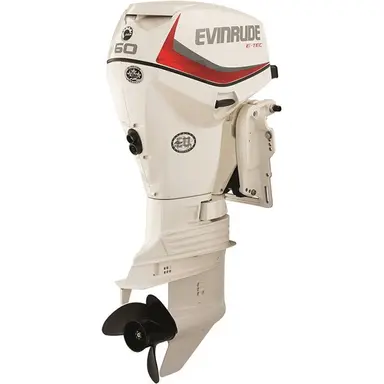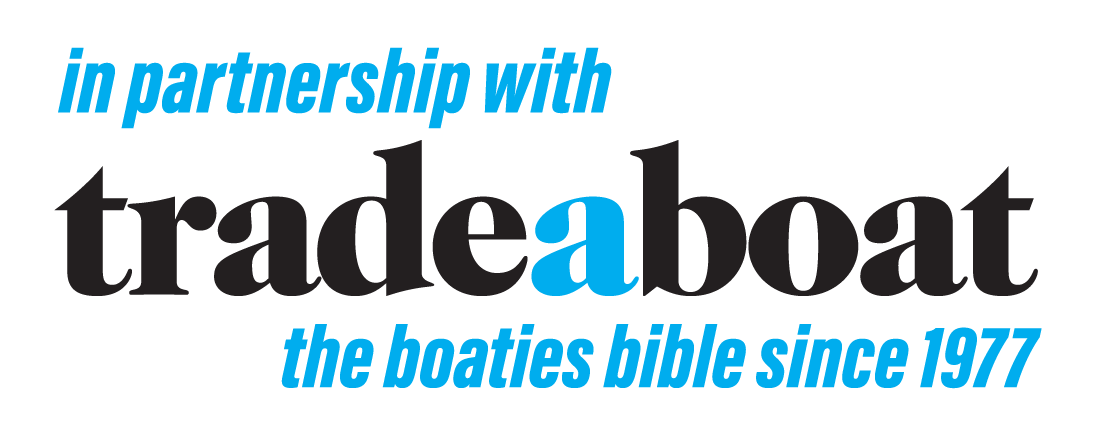
Evinrude E-TEC 60hp Outboard Motor Review
Way back in 1979, I did a stint selling Johnson outboards for a Sydney dealer. One of our most popular engines was the 737cc 55, a twin-cylinder twin-carbie engine that started life as a 50 in 1971. This was the second loop-charged outboard released by Outboard Marine Corporation after the three-cylinder 816cc Triumph 55 in 1968 (also the first Johno to have CD ignition), which eventually ended up as the legendary 70 (although this developed only 63 brake horsepower at the prop).
The 55 had plenty of grunt for powering tinnies to 5.2 metres and was economical for a carbie two-stroke of its output. The deep 2.42:1 gear ratio effectively converted engine torque to thrust at the prop, whereas the Japanese competition at the time had much taller gearing. Their smaller, lower units meant less drag at planing speeds but also slower hole shots due to greater prop slip — even though engines like Suzuki's 798cc DT50/60 developed more torque.
The 55 was later upgraded to a 60, which survived until Outboard Marine Corporation went under in 2000. This was a sad time for those of us weaned on Johnson outboards from our childhood.
During its steady development, the 55 was also released in a commercial version with overhead recoil starting and a massive 2.67:1 gear ratio for pushing heavy work boats. This lower unit was retained for the E-TEC 40 to 60 range released in the mid-2000s.
I remember Outboard Marine Australia's Graham Henniker telling me in the late nineties of the ability to make big twin-cylinder outboards that didn't shake around when trolling by re-engineering them with Direct Fuel Injection. The 55 sure gave a transom a workout below 1000 rpm and didn't start to smooth out until at least 2000 rpm. However, when Bombardier Recreational Products took over existing OMC engines, it didn't keep the 737cc 55 power head, so it opted for an 863cc engine, which was the largest displacement twin on the Aussie market.
The Nitty Gritty
Graham was right about getting rid of the shakes. By developing an entirely new range of twins with DFI—where the cylinder exhaust ports are closed off before the fuel is injected into the combustion chambers—the big twins ran smoother and at lower rpm when trolling. The twins had the same pistons and con rods as the three-cylinder E-TEC 75/90 and V4 115/130, making production more economical than having individual cylinder heads.
Unlike some four strokes in the 40–60hp range, where the cylinder bore diameter is actually less than the piston stroke measurement, Bombardier followed traditional two-stroke marine engineering by having massively over square or short stroke engines. This design dramatically reduces piston speed at higher rpm and increases component lifespan.
As with all E-TEC engines, there are no drive belts to fail. The under-flywheel alternator produces up to 81 amps, with 25 allocated for dedicated battery charging. The DFI management system is completely self-contained and doesn't require an external battery to function (as do the Orbital-developed Mercury OptiMax and Tohatsu TLDI DFI systems). This means a normal starter battery of 40–60 amp/hours (9.5–15kg) can be used instead of the 100-amp deep cycle battery (80kg and over) needed to maintain voltage over 11 for the Orbital systems. This makes E-TEC engines truly viable alternatives to carbie two-strokes when powering older hulls, because the massive battery weight just ahead of the transom doesn't need to be factored in. And if the starter battery is flat, E-TEC engines can be manually started — though you'd need to be bulked up before trying this!
Powerhead access is tight, but the lower cowl or engine pan can be split to reach all of the engine. The integral 1.9-litre tank for the variable ratio oil injection system is adequate for a full day of fishing. Bombardier recommends using fully synthetic XD100 oil, which is expensive but ensures low oil smoke emissions.
Bombardier states that no scheduled servicing is required for the first three years or 300 hours of running. However, every Evinrude dealer I've spoken with recommends greasing lubrication points and changing the gear oil annually. I also recommend removing the prop every six to 12 months to check for stray fishing line around the prop shaft, which can chew out the seal where the shaft enters the gear case.
On The Water
I've tested the E-TEC 40, 50 and 60, but the one that stood out was the 60: its power-to-weight ratio is the best, and the prop torque of the massive gear ratio (relative to hull size) is less noticeable than with the 50 and especially the 40. All three engines are no lightweights, but considering their engineering, this is understandable.
The demo 60 was mounted on a 4.8-metre Stacer 469 Easy Rider bow rider and was well-matched to this hull. The engine started instantly, hot or cold, with only a slight oil smell when backing upwind. Providing the anti-ventilation plate was kept at least three-quarters immersed, power astern was good (and useful for backing out of skinny water).
Below 1000 rpm, the big twin was noticeably rougher than the four-cylinder, four-stroke competition and slightly rougher than the three-cylinder, four-stroke competition, but nothing like the Johno 55. The 60 also idled down to lower rpm, giving the impression it could do so for hours on end without blowing oil smoke everywhere as the spark plugs steadily fouled in the 55 — particularly the surface gap plugs of the time that definitely weren't designed for extended trolling.
Above 1000 rpm, the 60 had smoothed out, and due to the large reduction and relatively coarse-pitch prop for a 60, our 830kg total at lower rpm than a four-stroke 60 would have. Even into a stiff headwind, the 60 maintained a clean plane at the same rpm as in calm water, indicating plenty of bottom-end to mid-range torque. The wheel steering masked prop steer torque, making the 60 far nicer to use than its tiller-steer counterparts.
Cruising at 4000 rpm, the 60 was quiet and fuel-efficient; no prop ventilation occurred through tight figure-eight turns at this rpm. However, as the rpm increased, the drag of the massive lower unit became apparent and limited our upper-end performance compared to higher-geared Carbie two-strokes in its power range. But I think that in a family boat such as the 469, the ability to plane easily and maintain a clean plane in rough water is more important than top-end performance.
At or near Wide Open Throttle, the 60 was noisier than the four-stroke competition but had no raspy exhaust note like the 55.
The Wrap
As an old fart raised on carbie two-stroke outboards, the E-TEC 60 has real appeal. I love its inherent design simplicity and that it performs like a two-stroke with the fuel efficiency of a four-stroke. Sure, its vibration levels at low rpm are higher than the four-strokes, but you're used to some vibration when you've been raised on big, shaky twins. Frankly, I think it's great that Bombardier still offers an alternative to the relatively complex four-strokes, and I hope it continues to do so for years to come.
The 60 has been around for a while now, so spares availability shouldn't be an issue, especially since its three- and four-cylinder counterparts share the same parts.
Sea Trials Evinrude E-TEC 60 hp Outboard
Single E-TEC 60 on Stacer 469 bow rider swinging a 15-inch stainless steel prop and pushing a total of 830 KG. Average of two-way runs on Tuggerah Lake, NSW. Range is in nautical miles from a 25-litre portable fuel tank with a 10% reserve.
|
Rpm |
Kts |
Lt/h |
Range |
|
650/trolling |
2.3 |
0.6 |
86 |
|
3100/planning |
11.6 |
5.8 |
45 |
|
4000/cruise |
18.4 |
7.9 |
52 |
|
5000/max cruise |
24 |
11.6 |
47 |
|
5800/WOT |
28.9 |
19.4 |
34 |
Specifications Evinrude E-TEC 60
-
Loop-charged DFI twin-cylinder two-stroke outboard
-
Rated BHP/MHP* 60.3/61.2 at 5750rpm
-
WOT rpm range 5500 to 6000 rpm
-
Piston displacement 863cc
-
Bore x stroke 91 x 66mm
-
Gear ratio 2.67:1
-
Dry weight long shaft 109 KG
-
OEDA stars3
*Brake horsepower/metric horsepower or PS
Ready to Set Sail?
Find your dream boat online at Only Boats! We have great deals on boats for sale, including used boats and new boats. You can also check out our used boat buying guide.
If you're upgrading or planning to sell your boat, why not explore our expert guide on how to improve boat resale value. If you're planning to attend a boat show soon, we've also put together a detailed boat show buying guide that's perfect for first time buyers.
Smooth sailing starts with the right boat. We’re here to help you find it!
This article was written by Andrew Norton and previously appeared at TradeaBoat.com.au, now powered by Only Boats.
Getting boat finance sorted shouldn't be the hard part of boat ownership. Credit One has helped thousands of Australians get on the water, earning a reputation as Australia's best-reviewed finance broker with 3,000+ glowing Google reviews to show for it. See what customers have experienced by reading their Credit One reviews, or use the loan repayment calculator to work through your options.
